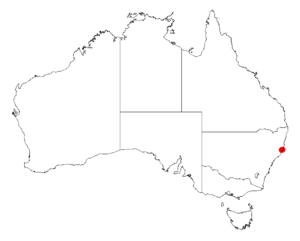Northern Brother wattle facts for kids
Quick facts for kids Northern Brother wattle |
|
|---|---|
| Conservation status | |
| Scientific classification | |
| Genus: |
Acacia
|
| Species: |
courtii
|
 |
|
| Occurrence data from AVH | |
The Northern Brother wattle (also called Acacia courtii) is a special tree found in eastern Australia. It's a type of Acacia, which is a large group of plants often called wattles. Sadly, this wattle is currently listed as a vulnerable plant. This means it needs protection to survive and thrive in the wild.
Contents
What Does It Look Like?
This wattle tree can grow quite tall, usually over 7 meters (about 23 feet) and sometimes up to 20 meters (about 65 feet) high! It has thin, delicate branches that hang down.
Like most Acacia trees, it doesn't have regular leaves. Instead, it has phyllodes. These are like flattened leaf stems that do the job of leaves. The phyllodes of the Northern Brother wattle are a blue-green color and feel flexible. They are long and thin, usually 5 to 18 centimeters (about 2 to 7 inches) long and 5 to 12 millimeters (less than half an inch) wide. They have a small hook at the end.
Flowers and Seeds
The Northern Brother wattle blooms between November and January. During this time, it grows cylindrical (tube-shaped) flower-spikes. These spikes are 3 to 6.5 centimeters (about 1 to 2.5 inches) long and are covered in bright golden flowers packed closely together.
After the flowers, the tree forms straight, woody seed pods. Inside these pods are shiny brown seeds. Each seed is about 5.5 to 7.8 millimeters long and has a small, twisted attachment called an aril.
Naming the Northern Brother Wattle
The scientific name for this tree, Acacia courtii, honors a botanist named Arthur Bertram Court. He used to be the Assistant Director of the Australian National Botanic Gardens. This wattle is also closely related to another wattle called Acacia orites.
Where Does It Grow?
The Northern Brother wattle is endemic to a very small area. This means it only grows naturally in one specific place. You can find it in the mid-north coast region of New South Wales, Australia. It grows around towns like Laurieton, Kendall, and Kew.
It usually lives on rocky hillsides within the coastal mountain ranges. It's part of dry forests and woodlands. There are only about six main groups of these trees known. Most of them are found in the Kerewong State Forest and around North Brother Mountain and Mid Brother Mountain.
This wattle often grows alongside other trees like different types of Eucalyptus (gum trees). Some common ones include Eucalyptus acmenoides, Eucalyptus gummifera, Eucalyptus intermedia, Eucalyptus siderophloia, and Eucalyptus umbra. You might also see other plants like Allocasuarina torulosa, Helichrysum elatum, Imperata cylindrica, Syncarpia glomulifera, and Themeda australis in its habitat.


